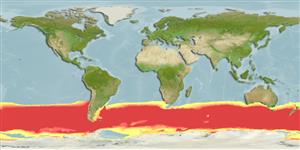>
Scombriformes (Mackerels) >
Gempylidae (Snake mackerels)
Etymology: Paradiplospinus: Greek, para = the side of + Greek, diploos = double + Latin, spina, pinna = thron (Ref. 45335).
More on author: Andriashev.
Issue
Validity of species questionnable for some authors, but no recent publications.
Environment: milieu / climate zone / depth range / distribution range
Écologie
marin bathypélagique; profondeur 0 - 2830 m (Ref. 6181). Deep-water; 31°S - 79°S, 180°W - 180°E (Ref. 6181)
Southern Ocean: circumpolar. In the belief that there was only a single species of Paradiplospinus, many authors used the name Paradiplospinus gracilis as including Paradiplospinus antarcticus.
Taille / Poids / Âge
Maturity: Lm ? range ? - ? cm
Max length : 52.0 cm SL mâle / non sexé; (Ref. 6181); common length : 35.0 cm SL mâle / non sexé; (Ref. 6181)
Épines dorsales (Total): 36 - 39; Rayons mous dorsaux (Total): 24-34; Épines anales 2; Rayons mous anaux: 25 - 31; Vertèbres: 64 - 67. Body is extremely elongate. Mouth with fang-like teeth, 3-6 fangs anteriorly in upper jaw and 1 fang on each side of the lower jaw. Pyloric caeca 6. Color is silvery white without any conspicuous marks except 40 - 50 narrow longitudinal lines of pale melanophores; the dorsal-fin base, opercular region and caudal-fin origin dark brownish.
Adults and subadults epipelagic to mesopelagic, or mesobenthopelagic at shelves and slopes from surface to 830 m (temp. 0° to 4°C). Larvae and juveniles, probably mesopelagic to bathypelagic, down to 2,830 m depth (Ref. 5084). Feeds on krill, squid and fishes (predominantly myctophids). Larval and juvenile specimens mostly obtained between southern land masses and the Antarctic continent.
Life cycle and mating behavior
Maturité | Reproduction | Frai | Œufs | Fécondité | Larves
Nakamura, I. and N.V. Parin, 1993. FAO Species Catalogue. Vol. 15. Snake mackerels and cutlassfishes of the world (families Gempylidae and Trichiuridae). An annotated and illustrated catalogue of the snake mackerels, snoeks, escolars, gemfishes, sackfishes, domine, oilfish, cutlassfishes,. scabbardfishes, hairtails, and frostfishes known to date. FAO Fish. Synop. 125(15):136 p. (Ref. 6181)
Statut dans la liste rouge de l'IUCN (Ref. 130435)
Menace pour l'homme
Harmless
Utilisations par l'homme
Pêcheries: sans intérêt
Plus d'informations
Noms communsSynonymesMétabolismePrédateursÉcotoxicologieReproductionMaturitéFraiRassemblement de ponteFéconditéŒufsDéveloppement de l'œuf
RéférencesAquacultureProfil d'aquacultureSouchesGénétiqueElectrophoresesHéritabilitéPathologiesTraitementNutrientsMass conversion
CollaborateursImagesStamps, Coins Misc.SonsCiguateraVitesseType de nageSurface branchialeOtolithesCerveauxVision
Outils
Articles particuliers
Télécharger en XML
Sources Internet
Estimates based on models
Preferred temperature (Ref.
123201): 0.8 - 7.8, mean 3.5 °C (based on 694 cells).
Phylogenetic diversity index (Ref.
82804): PD
50 = 0.7500 [Uniqueness, from 0.5 = low to 2.0 = high].
Bayesian length-weight: a=0.00363 (0.00163 - 0.00807), b=3.10 (2.91 - 3.29), in cm total length, based on LWR estimates for this (Sub)family-body shape (Ref.
93245).
Niveau trophique (Ref.
69278): 4.1 ±0.53 se; based on food items.
Résilience (Ref.
120179): Milieu, temps minimum de doublement de population : 1,4 à 4,4 années (Preliminary K or Fecundity.).
Fishing Vulnerability (Ref.
59153): Moderate to high vulnerability (45 of 100).
